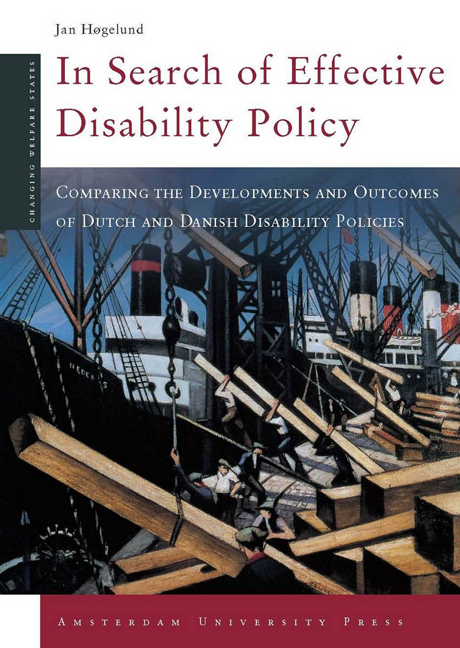 In Search of Effective Disability Policy
In Search of Effective Disability Policy Book contents
- Frontmatter
- Contents
- Acknowledgement
- 1 Disability Policies Under Pressure
- 2 The Integration of Disabled People:What Do We Know?
- 3 Bringing the Pieces Together:A Multidisciplinary Approach to Work Disability
- 4 Economic Miracles Bypassing Disabled People
- 5 Dutch Disability Reforms:Redefining Responsibilities
- 6 Danish Disability Policy:Small Steps,Big Change?
- 7 Different Routes to Integration
- 8 Different Policies – Different Outcomes
- 9 Too Much and Too Little:Employers’Responsibility in Denmark and the Netherlands
- Tables and Figures
- Notes
- References
- Index of Subjects
- Index of Names
5 - Dutch Disability Reforms:Redefining Responsibilities
Published online by Cambridge University Press: 15 January 2021
- Frontmatter
- Contents
- Acknowledgement
- 1 Disability Policies Under Pressure
- 2 The Integration of Disabled People:What Do We Know?
- 3 Bringing the Pieces Together:A Multidisciplinary Approach to Work Disability
- 4 Economic Miracles Bypassing Disabled People
- 5 Dutch Disability Reforms:Redefining Responsibilities
- 6 Danish Disability Policy:Small Steps,Big Change?
- 7 Different Routes to Integration
- 8 Different Policies – Different Outcomes
- 9 Too Much and Too Little:Employers’Responsibility in Denmark and the Netherlands
- Tables and Figures
- Notes
- References
- Index of Subjects
- Index of Names
Summary
In 1990 the Dutch Prime Minister declared the Netherlands ‘a sick country’ and that he would resign if the number of disability beneficiaries grew beyond 1 million (Aarts and de Jong, 1996b). At that time the disability problem had become synonymous with the crisis in the Dutch welfare state. It reflected an increasing problem of paid inactivity: the number of people receiving social benefits relative to the number of employed people had become alarmingly high. For every 100 employed more than 80 people were receiving some form of social security benefit (including old age pension) (Visser and Hemerijck, 1997). Combined with very luxury social security benefits this caused an economic crisis of serious dimensions. Not only did rising public expenditure and foreign debt threaten the functioning of the social security system, increasing taxes and social contributions also raised companies’ costs, thereby reducing their ability to earn money on international markets. The disability problem had also become synonymous with a seemingly ungovernable system: a first round of welfare reforms in 1985 and 1987 had almost no visible impact on the number of beneficiaries. More fundamental changes seemed necessary.
In 1991 the Dutch government launched a welfare reform package, which was the first step towards a major overhaul of the Dutch welfare system and in particular of the sickness and disability benefit programmes. During the 1990s changes within the organisation of the Dutch welfare system and insurance covering unemployment, sickness and disability aimed to restrict paid labour market exit and increase employment. The reforms were harsh. Eligibility criteria and entitlements to social security benefits were narrowed and benefit levels were reduced. Furthermore, organisational amendments significantly changed the institutional ‘rules of the game’ in that the influence of the social partners (unions and employers associations) was considerably restricted, while market forces were allowed to play an influential role in social security. This development has been labelled ‘managed liberalisation’ (Visser and Hemerijck, 1997; van der Veen and Trommel, 1999).
This chapter looks into the background of the disability crisis and into the reforms of the Dutch disability policy. The disability problem did not arise overnight, and had been known since the early 1980s, so why were the problems allowed to become so out of control?
- Type
- Chapter
- Information
- In Search of Effective Disability PolicyComparing the Developments and Outcomes of the Dutch and Danish Disability Policies, pp. 75 - 92Publisher: Amsterdam University PressPrint publication year: 2003


